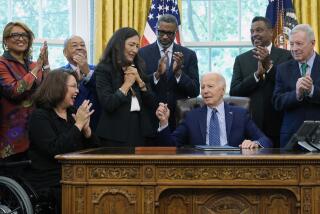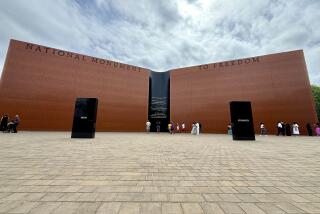A monument to Martin Luther King
Unless it’s postponed by Hurricane Irene, which is bearing down on Chesapeake Bay, the Martin Luther King Jr. Memorial is scheduled for dedication Sunday on the National Mall in Washington. Symbolism is everything when it comes to such memorials, and perhaps the stormy opening is appropriate for a monument that has undergone a quarter-century of battles over design, location and funding. But King’s history suggests that ferocious winds and driving rain are no match for a man of granite.
As is always the case with new memorials built in America’s highest-profile sculpture garden, there is plenty of controversy swirling around the King sculpture. Most of it centers on the fact that it was carved out of Chinese granite by Chinese artist Lei Yixin, with most of the work done at Lei’s studio in Changsha. Some are irked that it wasn’t made by an American artist — and more specifically, an African American. There is criticism that King looks slightly Asian, or that because he’s sculpted in white granite rather than black, he appears white. King would be “turning over in his grave” if he knew his statue had been sculpted by an artist from a communist regime, Denver sculptor Ed Dwight told London’s Telegraph newspaper. Maybe — or maybe he would have been thrilled that questions of ethnicity and nationality, and even the racial characteristics of his own likeness, were given so little consideration in a world whose racial vision is less constrained than in King’s day, in no small part because of King himself.
King’s memorial is the first on the Mall dedicated to an African American, and as such it represents a landmark. The monument’s concept originated with the black fraternity Alpha Phi Alpha, whose members thought the Mall needed more African American visitors — and a King statue was the way to draw them. It is indeed a welcome and overdue tribute to the diversity that has strengthened and enriched our nation. But just as significant is that the King monument, unlike most of Washington’s major memorials, is dedicated not to war veterans or war presidents such as Abraham Lincoln or Franklin D. Roosevelt but to a man who preached nonviolent resistance.
King wasn’t the mild pacifist that today’s school history texts often portray; he was a revolutionary and a firebrand, a vehement critic of the Vietnam War and an ardent supporter of organized labor whose last speech was delivered to striking sanitation workers in Memphis. Yet his consistent message was that racial harmony was achievable and that the best way to win equal rights was through peaceful protest. War memorials are a stirring way to honor those who have sacrificed their lives for the nation, but the Mall, as well as the nation’s conscience, are enlarged by this reminder that peace is part of progress and that it, too, deserves its place.
More to Read
A cure for the common opinion
Get thought-provoking perspectives with our weekly newsletter.
You may occasionally receive promotional content from the Los Angeles Times.










